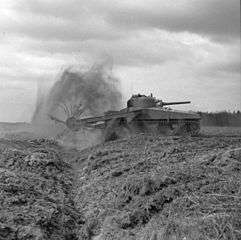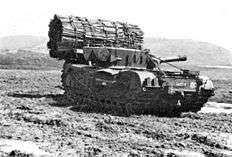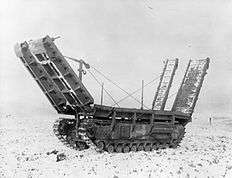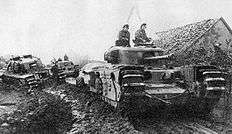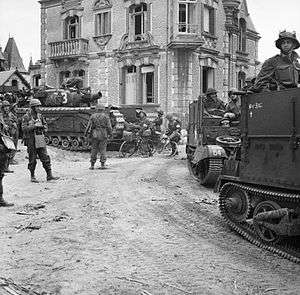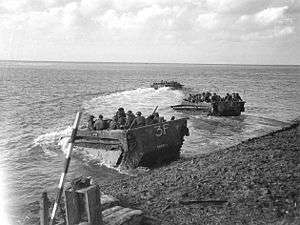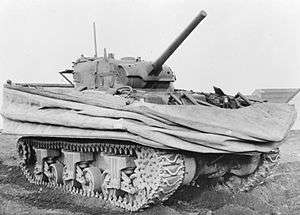79th Armoured Division (United Kingdom)
| 79th Armoured Division | |
|---|---|
|
Badge of the 79th Armoured Division | |
| Active | 14 August 1942–20 August 1945 |
| Country |
|
| Branch |
|
| Type | Specialised armour |
| Size | Division |
| Engagements |
Battle of Normandy Battle of the Scheldt Geilenkirchen salient Rhine crossing Elbe crossing, Battle for the Roer Triangle |
| Commanders | |
| Notable commanders | Major General Sir Percy Hobart |
The 79th Armoured Division was a specialist armoured division of the British Army created during World War II. The division was created as part of the preparations for the Normandy invasion of 6 June 1944, D-Day. The division operated armoured vehicles modified for specialist roles, intended to assist with the landings on the beaches. The division remained in action during the North-west European Campaign, providing specialised support during assaults to the 21st Army Group and, occasionally, to American units.
History
The division was formed as a standard armoured formation in November 1942, but, in March 1943, it was about to be disbanded for lack of resources. General Sir Alan Brooke, the Chief of the Imperial General Staff (CIGS), however, foresaw the need for specialised armoured vehicles and offered its command to Major-General Percy Hobart. Hobart accepted on the understanding that the 79th would be an operational division, not just a training and development one. The number assigned - 79 - appears to be in the higher infantry division series between the 78th Infantry Division and the low grade 80th Infantry (Reserve) Division. As an all-armoured formation, its infantry brigade, the 185th, was removed; the 27th Armoured Brigade remained as the nucleus of its new role, but was moved to the British 3rd Infantry Division in early 1944.
Hobart gave firm direction and the strange-looking tanks it developed and operated were known as Hobart's Funnies. They included tanks that floated, could clear mines, destroy defences, carry and lay bridges, and roadways - anything that would enable the invasion force to get ashore and break through the German defences. One less successful development was the Canal Defence Light a giant light intended to dazzle enemy gunners, although it was used to provide artificial daylight during the attack on the Geilenkirchen salient.
Initially, 79th Armoured Division also had the usual contingents of Royal Artillery, Royal Engineers and other Army units attached, but these were removed after its change of role. After formation in October 1942, the 79th, based at the time mostly in Yorkshire, trained as a regular armoured division for about six months before the change of role.
The Sherwood Rangers Yeomanry, two Canadian units (the 1st Hussars and Fort Garry Horse) and three American units were trained on DD tanks by the division though not part of the formation itself. In mid-1943, the Assault Brigade RE was formed: its units were Assault Squadrons RE.
The formation did not operate as a single division: its vehicles were distributed as small units across the Divisions taking part in the landings and subsequent operations. At first, difficulties were encountered in persuading infantry commanders to use the specialised armour to best effect, but these were resolved with the appointment of representatives of the GOC to each formation where elements were assigned. The units of the 79th were distributed as short term assets to a particular operation or battle and once complete returned to the 79th, the liaison officers of the 79th having the power to recall the vehicles.
The Division was further used during the battle for the Scheldt estuary (Operation Infatuate), the battle for the Roer Triangle (Operation Blackcock), the Rhine crossings (Operation Plunder) and the Elbe crossing to transport the assault troops and to re-supply.
The 79th Armoured Division was disbanded on 20 August 1945. Hobart subsequently commanded the Specialized Armour Development Establishment (SADE), which was formed from elements of the 79th together with the Assault Training and Development Centre.[1]
Unit insignia was a black bull's head with flaring nostrils superimposed over a yellow triangle; this was carried proudly on every vehicle.
Equipment
Sherman Crab
The Sherman Crab was a mine flail tank designed to clear a safe path through a mine-field by deliberately detonating mines in front of the vehicle. The Crab design was first used by the British during the North African Campaign. The Sherman Crab was a standard Sherman tank with the mine flail mechanism added.
The mine flail was a horizontal, rapidly rotating rotor held in front of the vehicle on two arms. Heavy chains (the "flails") fixed to the rotor continuously and violently struck the ground detonating the mines. The tank received little damage in the process, but had to travel slowly and the flails had to be replaced on a regular basis as the explosions broke the chains.
Churchill AVRE
The Churchill Armoured Vehicle Royal Engineers (AVRE) was a heavily modified Churchill III or IV that had a crew of six - five engineers that acted as the tank crew, and a driver. In place of the main gun was the "Petard", a 290mm spigot mortar which fired the 40 pound (18 kg) "Flying dustbin" demolition bomb. Designed to quickly destroy fortifications, the round had a 28-pound (13 kg) high-explosive warhead with a practical effective range of 90 metres.
The AVRE was designed after the Canadian failure at Dieppe. It could be fitted with numerous other attachments, such as mine ploughs, fascine bundles, carpet rollers, explosive placers, Bangalore torpedoes for clearing barbed wire obstacles, hand-emplaced demolition charges, amongst others. After the Second World War, the Churchill AVRE was re-armed with a breech-loaded low velocity 165mm demolition gun firing HESH shells.
Churchill ARK (Armoured Ramp Carrier)
A turretless Churchill with ramps at either end and along the body to form a mobile bridge. The Mark 1 had trackways over the tracks for vehicles to drive along. The Mark 2 was an improvised version and crossing vehicles drove directly on the Churchill's tracks.
Churchill Crocodile
One of the more notable Churchill variants, the Crocodile was a Churchill VII in which the hull machine gun was replaced with a flamethrower. The fuel was in an armoured wheeled trailer towed behind. It could fire several 1 second bursts over 150 yards. The Crocodile was one of "Hobart's Funnies".
Kangaroo armoured personnel carrier
The first Kangaroos were converted from M7 Priest self-propelled guns that had been used by the 3rd Canadian Infantry Division during the assault on Normandy. These were no longer needed, as their artillery regiments were re-equipped with towed 25 pdrs at the end of July. At a field workshop, they were stripped of the artillery equipment and the front aperture welded over, then sent into service carrying twelve troops. Since they carried infantry as a kangaroo carries its young, they were dubbed Kangaroos and the workshop carrying out the conversion also received that name. Infantry were said to be 'empouched' when they boarded a Kangaroo. They were first used in Operation Totalize south of Caen. At the end of August, the Priest Kangaroos were returned to the US Army, and other vehicles converted. The majority of vehicles converted were Canadian Ram tanks, but a few Shermans and other Priests were also used (which were sometimes referred to as "unfrocked" or "defrocked" Priests). The name Kangaroo was applied to any similar conversion. They were operated by the 1st Canadian Armoured Carrier Regiment (1CACR) during Canadian attacks on the various Channel ports in late 1944, and later by the 49th Armoured Personnel Carrier Regiment. Both units were under command of the 79th Armoured Division from October 1944 until the end of the war.
Buffalo LVT 4
The first "Buffalo" Landing Vehicle Tracked could hold 24 men or 4,500 pounds (2,000 kg) of cargo. Originally intended to carry replenishments from ships ashore, they lacked armour protection and their tracks and suspension were unreliable when used on hard terrain.
Travelling at a respectable six knots in the water and twelve mph on land, it could deliver 24 fully equipped assault troops to the beach, and supply supporting fire from two .30 cal. machine guns. As it was not armoured, its thin steel hull offered virtually no protection. Tracks performed well on sand, but not on tough surfaces.
The 79th used the Buffalo at the Battle of the Scheldt during the crossing of the Rhine along with the Terrapin.
Duplex Drive Sherman Tank
DD tanks (from "Duplex Drive" referring to its twin types of locomotion: tracks and propellers) were amphibious swimming tanks developed during the Second World War. The phrase is mostly used for the M4 Sherman medium tanks used by the Allies in the opening phases of the D-Day landings in 1944.
The swimming tank idea arose when it was realised that the first waves of infantry that reached an invasion beach would be acutely vulnerable without the support of tanks. However, if landing craft were used to carry those tanks, they themselves would be vulnerable to German heavy guns. The loss of too many landing craft would slow the movement of reinforcements from ships offshore and the invasion beaches would be choked with disabled and sunken landing craft. By giving tanks the ability to float, they could be launched from landing craft offshore and make their own way onto the beach.
Canal Defence Light
The Canal Defence Light (CDL) was a British "secret weapon" of the Second World War.
It was based on the use of a powerful carbon-arc searchlight to dazzle and confuse enemy troops. A demonstration had shown that the use of a vehicle mounted searchlight both disoriented the units facing it and masked activities behind the searchlight.
The searchlight was mounted in an armoured turret fitted to a tank. Initially, the Matilda tank was used, with its normal turret replaced by a cylindrical one containing the searchlight (the light emitting through a vertical slit) and a machine gun. This was later replaced by the US M3 Grant, which was superior in several ways; it was a larger roomier tank, better able to keep up with battle tanks, such as the Sherman, and it had a hull mounted gun that was unaffected by the replacement of its normal turret with the searchlight turret.
The light could be varied in two ways to further enhance any effect: The addition of a blue or amber filter would make the light source seem further away or closer respectively. The operation of a shutter would create a flickering effect.
The project was shrouded in secrecy. It was tested during Exercise Primrose in 1943 at Kilbride Bay with the result that it was determined to be "too uncertain to be depended upon as the main feature of an invasion".
| Equipment used by the 79th Armoured Division | ||||||||||||||||||||||
|---|---|---|---|---|---|---|---|---|---|---|---|---|---|---|---|---|---|---|---|---|---|---|
|
Order of battle
- 14 August 1942
The 79th Armoured Division was first raised as a conventional armoured division, with one Armoured Brigade, one Infantry Brigade and supporting arms.[2]
27th Armoured Brigade - Attached to the 79th Armoured Division from 8 September 1942 until 20 October 1943.
185th Infantry Brigade - Transferred out to 3rd Infantry Division on 9 April 1943.
- 2nd Bn Royal Warwickshire Regiment
- 1st Bn Royal Norfolk Regiment
- 2nd Bn King's Shropshire Light Infantry
HQ Royal Artillery – converted into 9th Army Group Royal Artillery 1 May 1943[3]
- 142nd (Royal Devon Yeomanry) Field Regiment, RA[4]
- 150th (South Notts Hussars Yeomanry) Field Regiment, RA[5]
- 55th (Suffolk & Norfolk Yeomanry) Anti-Tank Regiment, RA[6]
- 119th Light Anti-Aircraft Regiment, RA[7]
- 1943
30th Armoured Brigade - Transferred into the division on 17 October 1943.
1st Assault Brigade and Assault Park Squadron RE - Formed on 1 November 1943
- 5th Assault Regiment RE
- 6th Assault Regiment RE
- 42nd Assault Regiment RE
- Operation Overlord (Normandy landings)[8]
The Division was under direct command of 21 Army Group, portions being placed in support of the Second Army for Operation Overlord.
1st Assault Brigade and Assault Park Squadron RE (AVRE)
- 149 Assault Park Squadron, RE
- 5th Assault Regiment RE
- 77 Assault Squadron, RE
- 79 Assault Squadron, RE
- 80 Assault Squadron, RE
- 26 Assault Squadron, RE
- 6th Assault Regiment RE
- 81 Assault Squadron, RE
- 82 Assault Squadron, RE
- 87 Assault Squadron, RE
- 284 Assault Squadron, RE
- 42nd Assault Regiment RE
- 16 Assault Squadron, RE
- 617 Assault Squadron, RE
- 222 Assault Squadron, RE
- 557 Assault Squadron, RE
30th Armoured Brigade (Sherman Crab)
- Operation Market Garden
This is the order of battle on 17 September 1944, at the beginning of Operation Market Garden. The division was not involved in that battle, but was involved heavily in the battles for the Channel ports, such as Le Havre, and the Battle of the Scheldt.
30th Armoured Brigade (Sherman Crab)
1st Assault Brigade and Assault Park Squadron RE (AVRE)
- 5th Assault Regiment RE
- 6th Assault Regiment RE
- 42nd Assault Regiment RE
31st Tank Brigade (Churchill Crocodile/Kangaroo (armoured personnel carrier))
- 141st Regiment Royal Armoured Corps
- 1st Fife and Forfar Yeomanry
- 1st Canadian Armoured Carrier Regiment
- Operation Varsity (Rhine crossing)
This is the order of battle for the division on 23 March 1945, which was the commencement of the crossing of the River Rhine, and the beginning of the final advance into Germany. As can be seen, the establishment of the division had grown as the requirement for specialised armour had increased.
1st Assault Brigade Royal Engineers (AVRE)
- 5th Assault Regiment R.E.
- 6th Assault Regiment R.E.
- 42nd Assault Regiment R.E.
- 87 Assault Dozer Squadron, R.E.
- 149 Assault Park Squadron, R.E.
30th Armoured Brigade (Sherman Crab)
31st Armoured Brigade (Churchill Crocodile, Kangaroo (armoured personnel carrier))
- 1st Fife and Forfar Yeomanry (Crocodile)
- 141st Regiment Royal Armoured Corps (Crocodile)
- 7th Royal Tank Regiment (Crocodile)
- 49th Armoured Personnel Carrier Regiment (Kangaroo)
- 1st Canadian Armoured Carrier Regiment (Kangaroo)
- 1st Northamptonshire Yeomanry
- 1st East Riding Yeomanry
- 4th Royal Tank Regiment
- 11th Royal Tank Regiment
See also
Notes
- ↑ Fletcher, p. 39
- ↑ Joslen, p. 30.
- ↑ 9th AGRA at RA 39–45, accessed 30 March 2015
- ↑ 142nd Fd Rgt at RA 39–45, accessed 30 March 2015
- ↑ 150th Fd Rgt at RA 39–45, accessed 30 March 2015
- ↑ 55th A/T Rgt at RA 39–45, accessed 30 March 2015
- ↑ 119 LAA Rgt at RA 39–45, accessed 30 March 2015
- ↑ http://niehorster.org/017_britain/44-06-06_NEPTUNE/Land/div_GB_79.htm
References
- Richard Doherty, Hobart's 79th Armoured Division at War: Invention, Innovation and Inspiration, Barnsley: Pen & Sword, 2011, ISBN 978-1-84884-398-1.
- D. Fletcher, Swimming Shermans: Sherman DD Amphibious Tank of World War II, Osprey Publishing, 2006.
- Lt-Col H.F. Joslen, Orders of Battle, United Kingdom and Colonial Formations and Units in the Second World War, 1939–1945, London: HM Stationery Office, 1960/Uckfield: Naval & Military Press, 2003, ISBN 1-843424-74-6.
- Keegan, John; Kenneth Macksey (1991). Churchill's Generals. London: Cassell. pp. 250–254. ISBN 0-304-36712-5.
- Hastings, Max (1999). Overlord. London: Pan. p. 396. ISBN 0-330-39012-0.
- Hobart, P C S; Montgomery, Field Marshal (1945). The story of 79th Armoured Division October 1942-June 1945. Hamburg: 79th Armoured Division. p. 314.
External links
- Royal Artillery 1939–1945
- Royal Engineers Museum Royal Engineers and Second World War (Assault Engineers)
- Royal Engineers Museum Biography of Major General Sir Percy Hobart
- Royal Engineers Museum Royal Engineers and Operation Overlord
- "79 Armoured Division". Orders of Battle.com.
- http://www.operation-blackcock.com
- http://79armoured.moonfruit.com/

